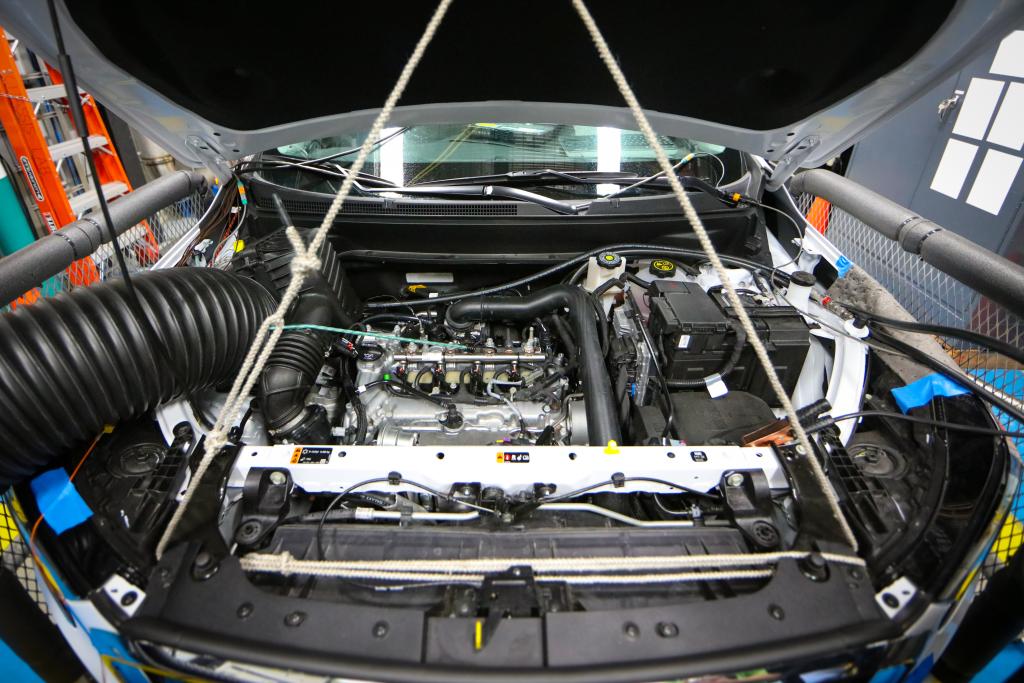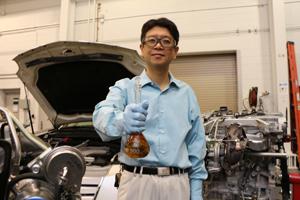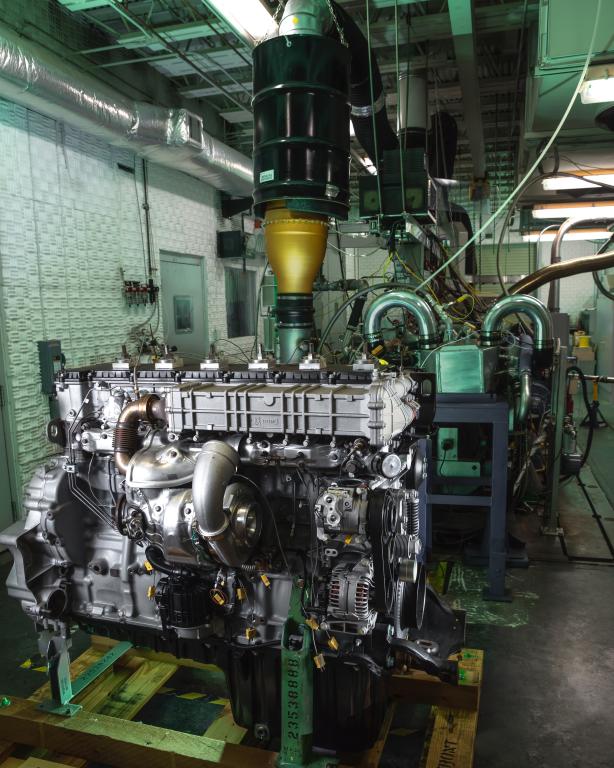Fuels, Engines and Emissions

The fuels, engines, and emissions research laboratory at Oak Ridge National Laboratory conducts research and development focused on the interrelated areas of advanced combustion engines, lubricants, fuels, and emissions controls. The primary goals of fuels and engines research are to develop knowledge and accelerate the deployment of renewable fuels and new technologies that increase vehicle efficiency, reduce petroleum consumption, and decrease harmful emissions.
Scientists from diverse backgrounds—including mechanical and chemical engineers, chemists, physicists, and environmental scientists—work closely with industry to develop and evaluate new engine technologies, alternative fuels, and emissions controls. Research is performed at all levels, from basic chemistry to component studies to engine systems and full vehicle applications. Scientists also leverage one-of-a-kind expertise and facilities at ORNL in the areas of leadership computing, neutron sciences, materials characterization, advanced manufacturing, and biosciences.
The ORNL team is highly engaged in both industry and government research on fuels, engines, and emissions technologies. The Department of Energy’s (DOE) Vehicle Technologies Office and Bioenergy Technologies Office along with industry partners are the main sponsors of fuels and engines research. Scientists work with industry through the Crosscut Lean Exhaust Emissions Reduction Simulations team, participate in the U.S. DRIVE and 21st Century Truck Partnership, and contribute to the U.S.-China Clean Energy Research Center for Clean Vehicles partnership. They participate in many cooperative research and development agreements with industry and perform sponsored research for engine manufacturers, automotive manufacturers, energy companies, and supplier organizations.
Researchers also fulfill leadership roles in professional societies such as the Society of Automotive Engineers International, the Combustion Institute, and the American Society of Mechanical Engineers. These activities allow scientists in fuels and engines to stay at the forefront of current engine research and emission controls issues.
One aspect of fuels and engines research is experiments and analysis about factors that affect real-world fuel economy, such as air conditioner use, maintenance, vehicle speed, and carrying extra cargo. Researchers in the adjacent Center for Transportation Analysis turn this data into driving tips for the public and post them on www.fueleconomy.gov, DOE’s most visited website. For example, fuels and engines research has demonstrated that dirty engine air filters do not affect fuel economy in modern vehicles, correcting decades of erroneous advice on this subject.

Fuels and Lubricants
Scientists study the impacts of fuels and lubricants on advanced combustion processes, exhaust species, and emissions control strategies and devices. A wide variety of fuels are studied, including gasoline and diesel, biofuels, natural gas, and hydrogen fuel cells. This also includes research focused on new non-conventional candidate fuels which enable improved efficiency and emissions. To support this effort, the fuels and engines team has developed a specially-equipped one-cylinder engine that can provide accurate performance and emissions results for small volumes of fuel, allowing start-up companies and other researchers the ability to evaluate prototype fuels.
ORNL research has informed the federal implementation of new fuels standards twice now, providing a basis for decision makers at the US Environmental Protection Agency (EPA) to allow use of E15 – gasoline with 15% ethanol—and mandate use of ultra low sulfur diesel fuel (ULSD).
Lubricants are another focus of study, since reduced friction and wear can increase vehicle fuel economy. Fuels and engines research spans the development of new lubricants, understanding the impact of lubricants on catalyst durability and engine-out emissions, and the development of new methods for characterizing the fuel economy potential of new lubricants. As an example, researchers partnered with General Motors to develop a low-viscosity lubricant featuring ionic liquid anti-wear additives that can boost fuel economy by 2% compared with commercially available synthetic 5W-30W oil. The team is working with additional ionic liquids and expanding the application of these lubricants to the rear axle with the goal of achieving a 4% improvement in vehicle fuel economy.
Engines
The fuels and engines group conducts research on innovative internal combustion engine technologies and control systems for improved efficiency. To understand the potential of new combustion concepts, researchers employ fundamental science, multi-cylinder implementations, full vehicle studies, and computer simulations.
Scientists are studying light- to heavy-duty engines with varied architectures. Research spans many forms of combustion including reactivity controlled compression ignition (RCCI) combustion, gasoline partially premixed combustion, and the use of in-cylinder thermo-chemical reforming to compensate fuel-specific differences on the combustion process. As an example, RCCI offers the potential to run an engine with diesel and gasoline simultaneously, controlling the ratios to achieve diesel-like efficiency with significant reductions in specific pollutant emissions. More conventional combustion approaches such as high-compression spark ignition engines are also being researched, exploring the benefits of high octane fuels.
Researchers leverage ORNL big science capabilities to advance transportation technologies. In one project, the fuels and engines team collaborated with Ford Motor Company, Convergent Science, and researchers at ORNL’s Leadership Computing Facility to use supercomputing to identify factors that promote combustion instability in spark-ignition engines. This condition can occur when using too much air or recirculation exhaust gases, which if used in the right ratios can significantly improve fuel efficiency and reduce emissions. The resulting computational model will be made available to industry, with the goal of addressing technical barriers inhibiting the development of next generation engines.

Emissions
Controlling vehicle emissions is necessary to meet federal regulatory standards, reduce health risks, and benefit the environment. New engine technologies and fuels cannot make it to the marketplace if they do not meet EPA emissions standards. Research at fuels and engines is focused on understanding the effect of new combustion and fuel technologies on emissions and developing advanced catalyst technologies for controlling emissions to regulated levels.
A key area of study is low temperature catalysis. Catalysts spur chemical reactions in the exhaust that turn pollutants such as HC, CO, and NOx into more benign substances (water, CO2, and nitrogen). Catalysts typically work well at high temperatures in the range of 300-800oC. As new technology increases engine efficiency, more of the heat generated during combustion is being used to create power and less heat escapes through exhaust. This creates the need for catalysts that work well at much lower temperatures (150oC).
Researchers are also developing improved understanding of the functions and key mechanisms of emission control devices such as lean NOx traps, urea selective catalytic reduction, and diesel particulate filters. By applying novel research tools, fuels and engines is able to provide unique insights into the chemistry occurring within catalysts and understand how surface chemistry impacts performance from the nanoscale to full-scale engine systems.
ORNL research has affected EPA regulations three times now. In addition to the rulings regarding E15 and ultra low sulfur diesel, EPA’s recent Tier 3 ruling uses a calculation developed by fuels and engines as part of the new certification process that takes effect in 2017 for light-duty cars and trucks. The calculation provides a cost-efficient way for automakers to determine the amount of NMOG emissions—non-methane organic gases that contribute to ground-level ozone. This calculation became part of new vehicle certifications beginning in 2017 and will reduce manufacturers’ test burden by simplifying the necessary exhaust measurements.
Unique Diagnostic Capabilities
The fuels and engines research team develops novel diagnostic instrumentation for use in research at the National Transportation Research Center and on-site at industry facilities such as engine plants. These instruments include the following.
- SpaciMS (spatially resolved capillary inlet mass spectrometer) allows researchers to take very small samples inside engine intake or exhaust valves and catalyst channels while in use to determine the samples’ chemical make-up and temperature with extreme accuracy. It is a portable, R&D 100 award-winning device.
- A rare configuration of DRIFTS (diffuse reflectance infrared spectroscopy) allows measurement of surface reactions on the catalyst, even at high temperatures and under normal humidity. The barrel ellipse attachment at ORNL is one of only five in the world and enables 10 times the sensitivity of measurement compared to more common configurations.
- Fuel-in-oil technology uses laser-induced fluorescence to determine the amount of fuel dilution in engine oil quickly and accurately, in real time. This tool enables combustion technology that improves fuel efficiency and keeps engines durable. It won an R&D 100 award and was licensed to Da Vinci Emission Services LLC.
- Exhaust gas recirculation (EGR) probe uses lasers to measure transient CO2 distributions throughout the engine intake system. Applying this tool to engines enables industry to balance multi-cylinder engines to maximize fuel efficiency and minimize emissions.
- Fiber optic–based phosphor thermometry allows highly accurate, non-contact temperature measurements. This tool has been used with fuel cells, catalysts, turbines, engine valves, and other applications to measure temperature in challenging environments.
As an example of our diagnostic tools in action, the fuels and engines team partnered with Cummins and used the EGR probe described above to optimize the engine efficiency for the Cummins-Peterbilt SuperTruck, which achieved 10.7 mpg under real-world driving conditions. This is a substantial improvement over typical heavy-duty trucks, which average 5.8 miles to the gallon. According to DOE, if all Class 8 trucks in the United States were SuperTrucks, the nation would save almost 300 million barrels of oil annually. The SuperTruck program is an initiative of DOE’s 21st Century Truck Partnership.

